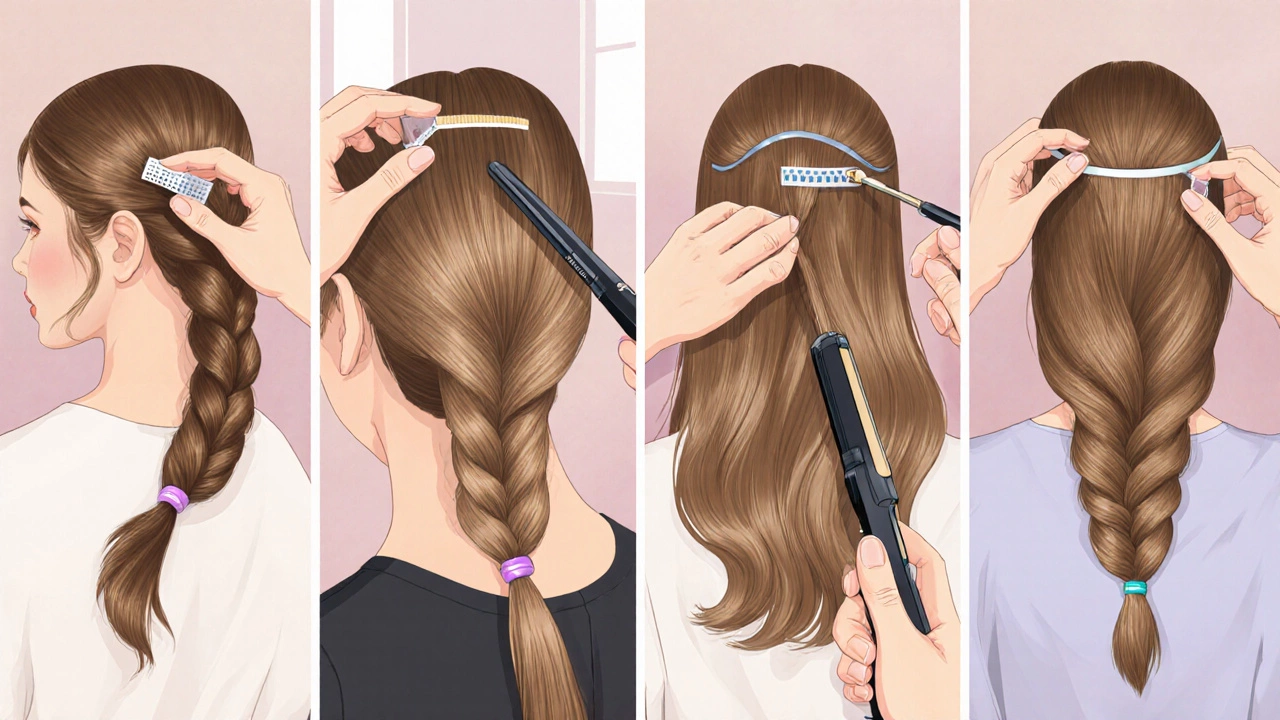
Hair Extension Selection Tool
Choose the Right Hair Extension for You
Answer a few questions about your needs to get personalized recommendations. This tool helps you match your lifestyle, budget, and hair type with the best extension type.
Recommended Extension Type
Key Benefits
Things to Consider
When you want extra length or volume without waiting months for natural growth, hair extensions become the go‑to solution. But with so many ways to attach extra strands, picking the best hair extension type can feel overwhelming. This guide walks you through the most common methods, reveals how each one performs in real life, and gives a clear decision framework so you can match the right extension to your schedule, budget, and style goals.
What are hair extensions?
Hair extensions are strands of natural or synthetic hair that are bonded to your own hair to add length, thickness, or both. They come in three basic categories: Clip‑in extensions, semi‑permanent methods like Tape‑in extensions, and permanent‑style bonding such as Sew‑in extensions or Fusion (bonded) extensions. Each technique balances three factors you’ll care about most: application time, durability, and maintenance effort.
Clip‑in extensions: Quick, affordable, and removable
Clip‑in extensions consist of wefts that snap onto a comb‑like clip. You can clip and unclip them yourself, making them ideal for special events or occasional volume boosts.
- Application speed: 5-10 minutes with no professional help.
- Cost: Typically $80‑$200 for a set of 12‑16 inches.
- Longevity: 1‑3 weeks if stored properly, then replaced.
- Pros: No heat or chemicals, easy DIY, low risk of hair breakage.
- Cons: Clips can slip with heavy activity, visible clip line if not blended well.
Best for: students, travelers, or anyone who wants the flexibility to wear extensions only when desired.
Tape‑in extensions: Seamless and lightweight
Tape‑in extensions are thin strips of hair pre‑cut to a specific length, adhered to your hair with medical‑grade double‑sided tape.
- Application speed: 1‑2 hours at a salon.
- Cost: $200‑$500 for a full head, depending on hair quality.
- Longevity: 6‑8 weeks before repositioning.
- Pros: Very natural look, low weight, easy to reposition.
- Cons: Requires professional removal to avoid pulling, tape can lose adhesion in high humidity.
Best for: clients who want a semi‑permanent solution with a natural blend and are comfortable regular salon visits.
Sew‑in and Fusion extensions: Long‑lasting, salon‑grade
Sew‑in extensions involve braiding a base into your hair and stitching wefts onto the braids using a needle. Fusion (bonded) extensions use a keratin‑based adhesive melted with a flat iron to fuse individual strands to your natural hair.
- Application speed: Sew‑in 2‑4 hours, Fusion 3‑5 hours (professional only).
- Cost: $300‑$800 for media‑length installations.
- Longevity: Sew‑in 8‑12 weeks, Fusion 3‑6 months.
- Pros: Very secure, can hold a lot of weight, suitable for thick or textured hair.
- Cons: Higher heat exposure (Fusion), potential for traction alopecia if installed too tightly, higher maintenance.
Best for: clients seeking a permanent‑style change, bridal parties, or anyone with a busy schedule who wants extensions to stay put for months.

Micro‑link and Halo extensions: Low‑profile and invisible
Micro‑link extensions use tiny, bead‑like rings that slide onto a tiny strand of your hair and clamp shut. Halo extensions are a single weft that wraps around the head, secured by a discreet, invisible band.
- Application speed: Micro‑link 1‑2 hours, Halo 10‑15 minutes.
- Cost: Micro‑link $250‑$600, Halo $120‑$250.
- Longevity: Micro‑link 2‑4 months, Halo 1‑2 weeks.
- Pros: No tape or glue, lightweight, easy to hide from the front.
- Cons: Micro‑link can cause tugging if rings are too tight; Halo can feel tight around the scalp.
Best for: those with fine hair who dread heavy extensions, or people who want an invisible front line for up‑dos.
Matching hair texture, color, and quality
Not all extensions blend the same. Remy hair - human hair collected so the cuticles stay aligned - offers the most natural shine and movement. Synthetic fibers are cheaper but can look shiny in a way that betrays their artificial origin.
- Texture match: Choose a curl pattern that mirrors yours (straight, wavy, curly). If you have mixed textures, a blend of 50/50 can work.
- Color blend: Use a professional colorist to add highlights or lowlights that mimic natural density variations.
- Length selection: Add no more than 2‑3 inches longer than your natural hair to avoid excessive weight.
Quality matters because lower‑grade hair sheds faster, leading to uneven appearance and more frequent replacements.
Maintenance checklist: Keeping extensions healthy
Regardless of the method, proper care prolongs life and protects your own hair.
- Gentle washing: Use sulfate‑free shampoo, apply only to the roots, and let the water run down the strands.
- Conditioning: Apply a leave‑in conditioner to the mid‑lengths, avoid the bonding area for tape‑in or fusion.
- Brushing: Use a wide‑tooth comb, start at the ends, and work upward.
- Heat styling: Keep temperature below 350°F; use a heat protectant spray.
- Night care: Wear a silk pillowcase or loosely tie hair in a low ponytail to prevent snagging.
- Salon visits: Schedule repositioning for tape‑in every 6‑8 weeks; check tension for sewn‑in every 2‑3 months.
Skipping any of these steps can cause tangles, premature shedding, or even damage to your natural scalp.

Comparison table: Quick glance at the main types
| Method | Application Time | Typical Cost (USD) | Durability | Maintenance Frequency |
|---|---|---|---|---|
| Clip‑in | 5‑10 min (DIY) | $80‑$200 | 1‑3 weeks | Wash & store weekly |
| Tape‑in | 1‑2 hr (salon) | $200‑$500 | 6‑8 weeks | Re‑position every 6‑8 weeks |
| Sew‑in | 2‑4 hr (salon) | $300‑$800 | 8‑12 weeks | Check tension monthly |
| Fusion (bonded) | 3‑5 hr (salon) | $400‑$1,200 | 3‑6 months | Professional removal & re‑apply |
| Micro‑link | 1‑2 hr (salon) | $250‑$600 | 2‑4 months | Adjust beads as hair grows |
| Halo | 10‑15 min (DIY) | $120‑$250 | 1‑2 weeks | Replace weekly for best look |
Decision guide: Which extension suits you?
Use the following flow to narrow down your choice:
- How often do you want them in? If only occasionally, go clip‑in or halo. For daily wear, consider tape‑in, micro‑link, or sew‑in.
- What’s your budget? Under $250 points to clip‑in or halo. Mid‑range $250‑$600 fits tape‑in or micro‑link. Premium $600+ unlocks fusion and high‑grade sew‑in.
- Do you have fine or thick hair? Fine hair benefits from lightweight tape‑in or micro‑link; thick hair can handle sew‑in or fusion without stress.
- How much maintenance are you comfortable with? Low‑maintenance fans choose clip‑in or halo. If you already visit a salon regularly, tape‑in or sew‑in blend nicely.
Match the answers with the table above, and you’ll land on a type that feels natural, looks great, and fits your routine.
Next steps and troubleshooting
If you’ve decided on a method but still have doubts, schedule a 15‑minute consultation with a certified stylist. Bring photos of your desired look and ask specific questions about:
- Weight limits for your scalp.
- Potential allergic reactions to adhesives.
- Long‑term effects on natural hair health.
Common issues and fixes:
- Slipping clips: Trim the clip’s tension or switch to a thicker weft.
- Tape edge lifting: Apply a thin line of hair glue or replace tape in humid seasons.
- Fusion breakage: Reduce heat exposure and schedule a professional check‑up every 3 months.
Remember, the "best" extension is the one that works for your life, not just the most popular.
Can I wear hair extensions if I have a sensitive scalp?
Yes, but choose low‑tension methods like clip‑ins or tape‑ins with breathable adhesives. Avoid heavy heat‑bonded fusion if you notice irritation.
How often should I wash my extensions?
Most experts recommend washing every 2‑3 days for tape‑ins and sewn‑ins, and once a week for clip‑ins. Use sulfate‑free shampoo and avoid the bonding area.
Will extensions damage my natural hair?
If installed correctly and maintained, damage is minimal. Problems arise from over‑tightening, excessive heat, or leaving extensions in too long.
Can I color my extensions at home?
Synthetic extensions can’t be dyed safely. Human Remy hair can be colored, but it’s best to have a professional match the shade to avoid uneven results.
Which extension type lasts the longest?
Fusion (bonded) extensions can stay up to six months when cared for correctly, making them the longest‑lasting option.
 Hair Care
Hair Care